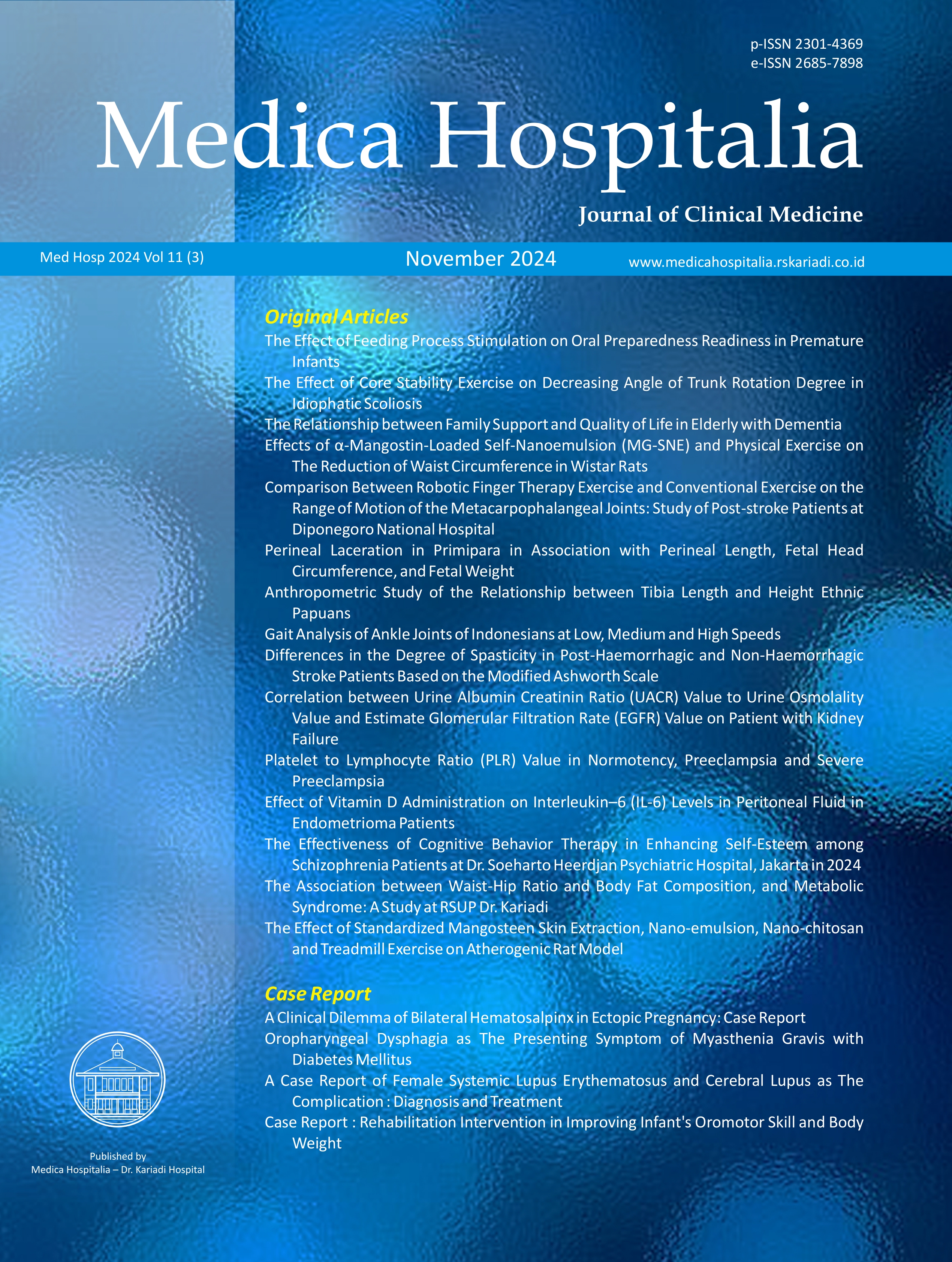Serum Protein D Surfactant Level Based on Length of Exposure in Workers at the Supit Urang Waste Disposal Site, Malang
DOI:
https://doi.org/10.36408/mhjcm.v12i1.1218Keywords:
Plasma Protein D Surfactant, waste workers, long exposure, high riskAbstract
BACKGROUND: Waste collectors are at risk of developing lung disease due to exposure to bioaerosols from organic and inorganic materials. The function of surfactant protein D (SP-D) is as innate immunity that protects the lungs. Exposure to bioaerosols in landfills causes inflammatory reactions which can increase the permeability of the blood-lung barrier. As a result, SP-D will leak into the plasma.
AIMS: This study aims to analyze serum SP-D levels in relation to length of exposure in waste collectors.
METHOD: This analytical, cross-sectional study was done in a Supit Urang waste disposal site, Malang, Indonesia. Samples for serum SP-D analysis were taken from peripheral blood samples and analyzed with ELISA technique.
RESULT: There were 68 subjects, consisting of 24 subjects with exposure duration of 5 years, 14 subjects of 5-10 years, and 30 subjects with exposure of 10 years. The number of smokers and non-smokers were 36 and 32 subjects respectively. Significant differences in SP-D serum levels were found between different exposure durations, particularly with exposure of more than 5years. A significant positive correlation was obtained between serum SP-D levels and exposure duration (r = 0,585; p = 0,000). Meanwhile, there was no significant difference in serum Sp-D levels based on smoking status (p=0.112).
CONCLUSION: Length of exposure significantly affected SP-D serum levels in waste workers, especially with exposure of more than 5 years.
Downloads
References
1. Ferronato N, Torretta V. Waste mismanagement in developing countries: A review of global issues. Vol. 16, International Journal of Environmental Research and Public Health. MDPI AG; 2019. p. 1-28.
2. Gupta N, Yadav KK, Kumar V. A review on current status of municipal solid waste management in India. Vol. 37, Journal of Environmental Sciences (China). Chinese Academy of Sciences; 2015. p. 206–17.
3. Vitorino de Souza Melaré A, Montenegro González S, Faceli K, Casadei V. Technologies and decision support systems to aid solid-waste management: a systematic review. Vol. 59, Waste Management. Elsevier Ltd; 2017. p. 567–84.
4. Raulf M, van Kampen V, Neumann HD, Liebers V, Deckert A, Brüning T, et al. Airway and blood inflammatory markers in waste collectors. In: Advances in Experimental Medicine and Biology. Springer New York LLC; 2017. p. 1–14.
5. Vinti G, Bauza V, Clasen T, Medlicott K, Tudor T, Zurbrügg C, et al. Municipal solid waste management and adverse health outcomes: A systematic review. Vol. 18, International Journal of Environmental Research and Public Health. MDPI; 2021. p. 1-28.
6. Kaza, S., Yao, L., Bhada-Tata, P. and Woerden, F. (2018). WHAT A WASTE 2.0 A Global Snapshot of Solid Waste Management to 2050 OVERVIEW. [online] Available at: https://openknowledge.worldbank.org/server/api/core/bitstreams/92a50475-3878-5984-829e-0a09a6a9badc/content. p.1-38.
7. Vaccari M, Tudor T, Vinti G. Characteristics of leachate from landfills and dumpsites in Asia, Africa and Latin America: an overview. Vol. 95, Waste Management. Elsevier Ltd; 2019. p. 416–31.
8. Vaccari M, Vinti G, Tudor T. An analysis of the risk posed by leachate from dumpsites in developing countries. Environments - MDPI. 2018 Sep 1;5(9):1–17.
9. Carreto-Binaghi LE, Aliouat EM, Taylor ML. Surfactant proteins, SP-A and SP-D, in respiratory fungal infections: their role in the inflammatory response. Respir Res. 2016 Dec 1;17(1):66.
10. Okamoto T, Fujii M, Furusawa H, Tsuchiya K, Miyazaki Y, Inase N. The usefulness of KL-6 and SP-D for the diagnosis and management of chronic hypersensitivity pneumonitis. Respir Med. 2015 Dec 1;109(12):1576–81.
11. Moazed F, Burnham EL, Vandivier RW, O’Kane CM, Shyamsundar M, Hamid U, et al. Cigarette smokers have exaggerated alveolar barrier disruption in response to lipopolysaccharide inhalation. Thorax. 2016 Dec;71(12):1130–6.
12. Khan R, Muhammad Waseem H, Usman Ahmad H, Ajmal Khan R, Parvez Lone K. Plasma surfactant Protein-D levels in healthy subjects and COPD patients patients [Internet]. Article in Journal of the Pakistan Medical Association. 2019. Available from: https://www.researchgate.net/publication/333703641
13. Klont F, Horvatovich P, Ten Hacken NHT, Bischoff R. Cigarette smoking prior to blood sampling acutely affects serum levels of the chronic obstructive pulmonary disease biomarker surfactant protein D. Vol. 58, Clinical Chemistry and Laboratory Medicine. De Gruyter; 2020. p. E138–41.
14. Sorensen GL. Surfactant protein D in respiratory and non-respiratory diseases. Vol. 5, Frontiers in Medicine. Frontiers Media S.A.; 2018.p.1-37
15. Sorensen GL, Dahl M, Tan Q, Bendixen C, Holmskov U, Husby S. Surfactant protein-d-encoding gene variant polymorphisms are linked to respiratory outcome in premature infants. Journal of Pediatrics. 2014 Oct 1;165(4):683–699.
16. Moré JM, Voelker DR, Silveira LJ, Edwards MG, Chan ED, Bowler RP. Smoking reduces surfactant protein D and phospholipids in patients with and without chronic obstructive pulmonary disease. BMC Pulm Med. 2010 Oct 25;10.p. 1-8.
17. Ratih Dwi Ary Merdekawati, Tri Wahju Astuti, Garinda Alma Duta. Increased Serum SP-D Level, Neutrophils and Lymphocytes Sputum in Malang Splendid Bird Market Workers. JURNAL RESPIROLOGI INDONESIA. 2022 Apr;42(2):129–35.
18. Odewabi AO, Ajibola RS, Oritogun KS, Ekor M. Levels of Clara cell secretory protein and surfactant protein A in municipal solid waste management workers in Ibadan, Southwest Nigeria. Toxicol Ind Health. 2023 May 1;39(5):267–80.
19. Tschopp A, Bernard A, Thommen AM, Jeggli S, Dumont X, Oppliger A, et al. Exposure to bioaerosols,,respiratory health and lung-specific proteins: A prospective study in garbage and wastewater workers. Occup Environ Med. 2011 Nov;68(11):856–9.
20. Daneshzadeh Tabrizi R, Bernard A, Thommen AM, De Winter F, Oppliger A, Hilfiker S, et al. Surfactant protein-D and exposure to bioaerosols in wastewater and garbage workers. Int Arch Occup Environ Health. 2010 Dec;83(8):879–86.
21. Fitri Indah Sari, Tri Wahju Astuti, Rezki Tantular. Exhaled Carbon Monoxide (eCO) and Serum CC16 Levels in Active Smokers. Jurnal Respirologi Indonesia. 2021 Jul;41(3):200–6.
22. Eriksen E, Afanou AK, Straumfors A, Graff P. Bioaerosol-induced in vitro activation of toll-like receptors and inflammatory biomarker expression in waste workers. Int Arch Occup Environ Health. 2023 Sep 1;96(7):985–98.
23. Liao JP, Wang X, Liu F, Cheng Y, Hu ZW, Zhang LN, et al. Serum surfactant protein D, lung function decline, and incident chronic obstructive pulmonary disease: A longitudinal study in Beijing. J Thorac Dis. 2021 Jan 1;13(1):92–100.
Additional Files
Published
How to Cite
Issue
Section
Citation Check
License
Copyright (c) 2025 Zata Dini, Tri Wahju Astuti , Rezki Tantular (Author)

This work is licensed under a Creative Commons Attribution-ShareAlike 4.0 International License.
Copyrights Notice
Copyrights:
Researchers publishing manuscrips at Medica Hospitalis: Journal of Clinical Medicine agree with regulations as follow:
Copyrights of each article belong to researchers, and it is likewise the patent rights
Researchers admit that Medica Hospitalia: Journal of Clinical Medicine has the right of first publication
Researchers may submit manuscripts separately, manage non exclusive distribution of published manuscripts into other versions (such as: being sent to researchers’ institutional repository, publication in the books, etc), admitting that manuscripts have been firstly published at Medica Hospitalia: Journal of Clinical Medicine
License:
Medica Hospitalia: Journal of Clinical Medicine is disseminated based on provisions of Creative Common Attribution-Share Alike 4.0 Internasional It allows individuals to duplicate and disseminate manuscripts in any formats, to alter, compose and make derivatives of manuscripts for any purpose. You are not allowed to use manuscripts for commercial purposes. You should properly acknowledge, reference links, and state that alterations have been made. You can do so in proper ways, but it does not hint that the licensors support you or your usage.
























